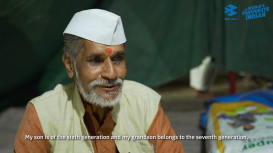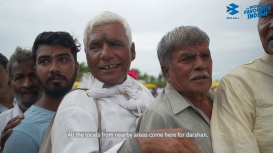Pandharpur, a small temple town on the banks of the Chandrabhaga river in Maharashtra, sees lakhs of devotees pour into its precincts on the auspicious day of the Ashadi Ekadashi (eleventh day of the bright fortnight of the Hindu month of Ashadh). Most of them have been walking for several weeks, as a part of the palkhi (palanquin) procession of one of the region’s many sant-kavis (exemplar devotees and poets). A palkhi carried on the shoulders of devotees or on a chariot enshrines the symbolic footprints or padukas of a sant-kavi. Processions usually start from the samadhis (memorial sites) of the sant kavis and can take up to 50 days to reach their destination: the temple of Vitthal and Rukmini in Pandharpur.
Vitthal is the patron deity of the Warkari panth (religious tradition) and is considered to be a form of Vishnu-Krishna. In the temple at Pandhapur, his black murti stands alongside that of his consort Rukmini, both their elbows pointing outwards and their hands rested on their hips. Credit for bringing Vitthal to Pandharpur goes to Pundalik, whose devotion to his parents so impressed the deity that He appeared in person to give him darshan. So busy was Pundalik in fulfilling his filial duties however, that he made even Vishnu wait by asking him to stand on a vit (‘brick’ in Marathi). Thus did the deity get his name as well as his distinctive stance.
The 17th-century sant-kavi Tukaram questions Pundalik’s audacity:
Hey Pundya! Why are you so proud
As to make Vitthal stand there?
Why are you so bold
As to toss a brick to him?
(Dhere, The Rise of a Folk God, 28)
The Warkari panth derives its name from this pilgrimage, called wari in Marathi: a Warkari is anyone who goes on the wari. Similar pilgrimages takes place four times a year, but the Ashadi wari is the largest and is considered most auspicious.
Today, the largest palkhi processions are those dedicated to Dyaneshwar and Tukaram. In the 13th century, Dyaneshwar wrote a Marathi commentary on the Bhagwad Gita which has become the core text of the Warkaris (the Dyaneshwari). Tukaram wrote abhangas or devotional poems for Vitthal, and saw bhajans and kirtans as the prime expression of bhakti. Tukaram wore Dyaneshwar’s padukas round his neck when he went on the wari, starting the tradition of carrying sants’ padukas to Pandharpur. After his passing, the same palkhi carried Tukaram’s own padukas (from his samadhi at Dehu) and the padukas of Dyaneshwar (from Alandi), but the latter soon became a separate procession. These two palkhis are consequently the oldest, but over the years new palkhis started making their way to Pandharpur and today their number is in the hundreds.
The Warkari panth is comprised largely of Marathi speakers who gather from all over western India. Most of them are from agrarian backgrounds and there is no restriction on who can be a Warkari. Several Warkari sant-kavis are said to be from so called ‘lower castes’ with Tukaram identifying himself as a Sudra, and Chokhamela as an untouchable Mahar. Their poetry is often scathing about caste-based discrimination:
Being the patriarch
Of no monastery
But a mere
Shopkeeper
No high priest no seer
No necromancer
No exorcist
No witch doctor
…
There’s no voodoo about Tuka
Tuka is like
None of these
Hell begotten lunatics.
Tukaram (translated by Arun Kolatkar, Collected Poems in English, 323)
A throne for one,
a hovel for another,
yet one other wanders bare.
One half-fed, another feasting,
For some not a scrap for the asking;
Chokhamela (translated by Rohini Mokashi-Punekar, On the Threshold, 111)
The panth lacks any centralized institutional authority and privileges the inward experience of bhakti over highly ritualized or scripture-based modes of worship. Women sant-kavis like the 13th-century Muktabai and Janabai are revered by Warkaris and their abhangas are popular:
the zoom ant
swallowed the sun
the barren woman
begot a son
…
a pregnant fly
delivered a kite
having seen it all
Mukta smiled
Muktabai (Kolatkar, Collected Poems in English, 302)
i eat god
i drink god
i sleep on god
i buy god
i count god
i deal with god
Janabai (Kolatkar, Collected Poems in English 299)
The Warkaris travel in dindis, smaller organizational units in which groups band together —eating, singing and setting up camp with each other. A dindi can have 10 to over 500 people.
In the Dyaneshwar palkhi procession, Warkaris always address each other as Mauli (another name for Dyaneshwar). This address, which has the connotations of ‘mother’, creates a unique sense of community, speaking at once of the equality of all participants as well as of the ‘presence’ of the 13th-century sant-kavi whose padukas they are carrying to Pandharpur.
Our team accompanied the Dyaneshwar palkhi over the last seven days of its journey to Pandharpur when a multitude of people lost themselves in each other’s company, as they had been doing for centuries, perhaps in the hope of finding themselves.
References
Dhere, R.C. The Rise of a Folk God: Vitthal of Pandharpur. Translated by Anne Feldhaus. New York: Oxford University Press, 2011.
Keune, Jon, and Christian Lee Novetzke. ‘Varkari Sampraday.’ In Brill’s Encyclopedia of Hinduism. Vol. 3, Society, Religious Specialists, Religious Traditions, Philosophy. Edited by Knut A. Jacobsen, 617–626. Leiden, The Netherlands, and Boston: Brill, 2011.
Kolatkar, Arun. Collected Poems in English edited by Arvind Krishna Mehrotra. Tarset: Bloodaxe, 2010.
Mokashi, D.B. Palkhi: An Indian Pilgrimage. Translated by Philip C. Engblom, with introductory essays by Philip C. Engblom and Eleanor Zelliot. Albany: State University of New York Press, 1987.
Mokashi-Punekar, Rohini. On the Threshold: Songs of Chokhamela. Delhi: The Book Review Literary Trust, 2002.
Sahapedia is grateful to Baja Autos Pvt. Ltd. for the grant that made possible the documentation for this module.



